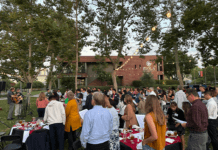By that, I mean that every internet broadcast of a Sunday worship service is not necessarily meant to be an online church. In that way, churches simply broadcasting their services to Facebook or YouTube is not much different than the rise of churches broadcasting services on television in the 80s and 90s. Some churches have an online ministry that is just an extension of their physical gathering.
Church Online, however, is often intended as an alternative way to be a part of the church, similar to another geographic campus. In fact, as we’ve emerged from the COVID shutdowns of the last two years, many churches have elevated their digital streaming to “campus” status and have even hired campus pastors to drive community engagement within digital spaces. Church Online is defined (by many) as a full expression of the local church in a digital space.
What was a necessary concession in 2020 has evolved into a featured product in 2022, but I’m not sure that is helpful in many cases.
It is true that, if a church is offline, it is not fully engaging its culture. But at its core, the ideal expression of church community is (among other things) a gathering of believers under the lordship of Jesus Christ. When Christians gather, they share the Lord’s Supper, they baptize new converts, they worship in concert with one another, and they seek to advance the kingdom of God while holding each other accountable as a covenantal family.
I don’t think Church Online can do that. At least, not in its entirety. Yes, I am aware of online baptisms and virtual communion, but we are discussing whether you should do that, not whether it is physically possible.
Fundamentally, a deep theological connection exists between the Christian life and real, flesh and blood type relationship. John 1 reminds us that Christ himself, in his desire to be among us, took on flesh (v. 14). We run the risk of eliminating that deep connection to incarnational presence with one another when we look at disembodied gatherings behind individual screens as a complete and total substitute for the real thing.
Participants of Church Online may cite avoiding traffic or other rationale as the motivation to stay home and tune in, and there are times when this approach may be necessary for exceptional reasons. Early COVID precautions obviously made digital gatherings a necessary, though temporary, substitute. But if we’re not careful, we may fall into the trap of avoiding (intentionally or unintentionally) real community.
Churches that have an online presence can avoid that tendency by explaining that the online option is not the full experience of or intent for church. That doesn’t mean that churches that have online campuses should shut them down and lay off their newly minted online campus pastors. What it does mean is that churches should be intentional about pointing online participants toward physical community.
Now, there are obvious and important caveats. Persons with special needs, those who have restrictions to gather, and those we once called homebound, have always mattered to the church. In years past (and still today), some churches would deliver communion to homes. Online ministry has opened up such ministry to many in those situations.
So, in general, your discipleship plans for online attenders should include physical church gatherings. Put another way, the best kind of community takes feet and faces, not just electrons and avatars.
Online church makes a great tool, but it makes a bad goal. The goal, with exceptions caused by a variety of factors from disability to accessibility, is embodied community.
3. What About Online Community?
When churches shifted to online gatherings during COVID lockdowns, many congregations opted out of streaming services to passive participants. Instead, they chose to meet via Zoom or other dialogue-optimized platforms that would allow for a measure of face-to-face interaction characteristic of a physical church gathering.
Regardless of how your church chose to navigate those times, we can safely conclude two things: 1) it is possible to have great online community, and 2) online community still isn’t a complete replacement for real, physical presence. Online community can be great, but it’s not enough. Online should enhance, not replace, personal presence in community.











